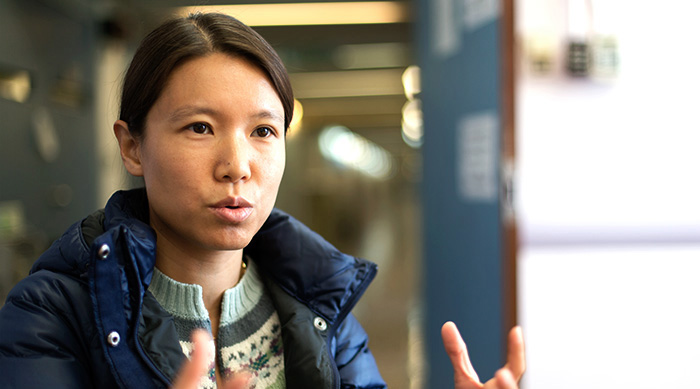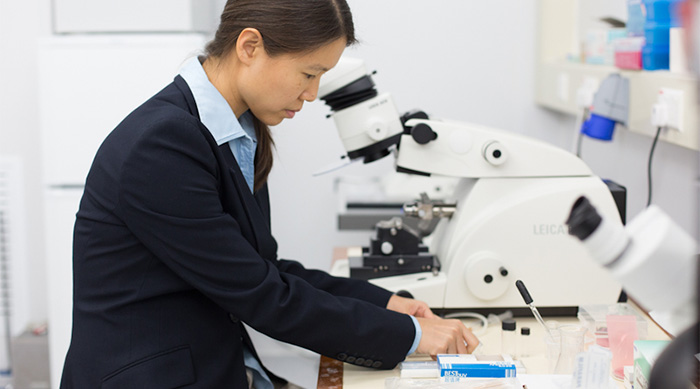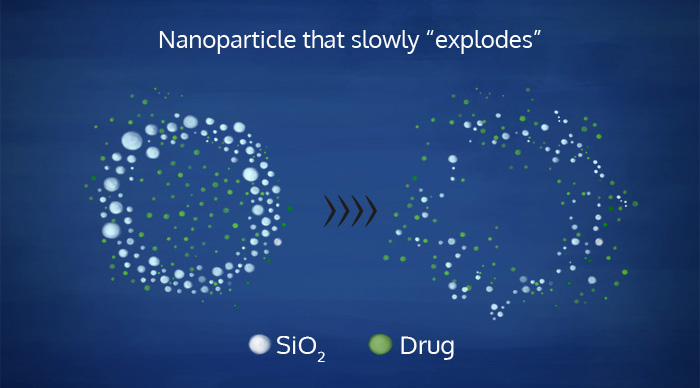Dear readers, With the launch of e-newsletter CUHK in Focus, CUHKUPDates has retired and this site will no longer be updated. To stay abreast of the University’s latest news, please go to https://focus.cuhk.edu.hk. Thank you.
Delivering Drugs in a Revolutionary New Way

Prof. Li Quan
Department of Physics
It was an accidental discovery that put Prof. Li Quan onto the path that has led to her most significant work, a way of delivering drugs into the body that could revolutionize how drugs are administered. She and a doctoral student were trying to load drugs into a tiny nanoparticle made of silicon dioxide when they discovered that the particle hollowed out over time.
That was significant because it suggested a drug could be placed in the middle of the particle and absorbed gradually by the body. But the scientists were unable to replicate the findings that they had stumbled upon, so they set the work aside for months, revisiting it from time to time.
That time paid off. In a "Eureka" moment, the student realized they had been conducting their experiments only over the course of a week, examining a drug-laden particle and then revisiting it seven days later, when it would be empty. No one knew where the drugs had gone. But the student, Zhang Silu, realized it was important to check the progress every day. When she and Professor Li did, they realized the drug was being released gradually, a perfect way of dosing out many drugs that require multiday or long-term treatment.
"Once we saw it, we knew that was the thing we were looking for actually," Professor Li, a material scientist and a physics professor of CUHK, recalls. "With our system, we see that there is a range that we can manipulate for the drug concentration. Not too high, not too low."

Professor Li's new way of administering drugs uses a "delivery vehicle" made of silicon dioxide, the same substance as glass and sand. The compound is inert, doesn't interact with the body and can be flushed out without any negative effects – whereas many other substances that could theoretically serve the role are toxic.
"Most of the common particles that have been researched today will accumulate in organs such as the liver or the spleen," Professor Li says. They stay in the liver for a while before being removed through the faeces, in the meantime having a negative effect on the cells there.
Silicon dioxide can be removed through the kidneys and urine, flushing through the system much faster. For that to happen, though, the particles must be very small, running the risk that they will either not be able to carry a meaningful amount of a drug or that they will simply exit the body immediately without the drug taking any effect.
Professor Li's work, which she has conducted in partnership with Prof. Lin Ge from the School of Biomedical Sciences of CUHK, has targeted particles that range from 20 to 100 nanometres. "You want to start with something that is large, and that large thing becomes small, and that solves your problem," she says. "It is rather like using a big hammer to smash a big rock, and the small pieces can float and get out."
The new system has the drug or drugs most heavily concentrated in the middle of the particle, allowing for a long-lasting controlled release, with a smaller amount of the drug on the outside that the body absorbs immediately. In traditional pills, the drug is just part of the pellet and isn't "hiding" in the middle of the particle, so it is all released right away.
The silicon-dioxide particles are initially too big to be filtered out by the kidneys. But they "explode" gradually, with the particle hollowing out as the drug is absorbed until the silicon dioxide "shell" bursts apart, allowing the body to wash out the harmless fragments.
That way of delivering drugs could be used in a wide range of applications. It's likely to be useful when it's important for the body to retain the drug for a long time, such as with blood-pressure control, nutrition or antibiotics. The drug can remain in the body for as long as a few weeks.
Professor Li initially envisioned those kind of uses, hoping that, for instance, a patient might be able to take one antibiotic pill that would last for five days, instead of taking pills three times a day, which reduces the chance that patients will complete the course.
But Professor Li has also discovered that such a drug-delivery system would also allow the administration of several drugs at once. It's a significant advantage over other methods of administering medication, which require each drug to be dosed out individually.
That would be important in the treatment of cancer, where many drugs are required to treat the disease. Administering them all at once would make them more effective, not letting the cancer cells develop the multi-drug resistance that they can achieve when treatment with individual drugs takes more time.

"Cancer cells are very smart, they develop a system to fight back," Professor Li says. "People like the idea of different drugs attacking different things in the cells at once. If one drug is blocked, other drugs can attack, and it makes it difficult for the cancer cells to fight back."
The slow release of the drugs also allows for a stealthier attack on the cancer cells, drip-feeding the drug into them subtly. That prevents them developing the defenses they deploy if suddenly attacked by a larger amount of a drug.
The tests are moving from the lab into "in vivo" tests with rats. They are still some way from clinical human trials, and each drug would have to be tested with the delivery system, one by one. But the early results look very promising. "We have seen this working in the cells," Professor Li says.
By Alex Frew McMillan
This article was originally published on CUHK Homepage in Mar 2014.